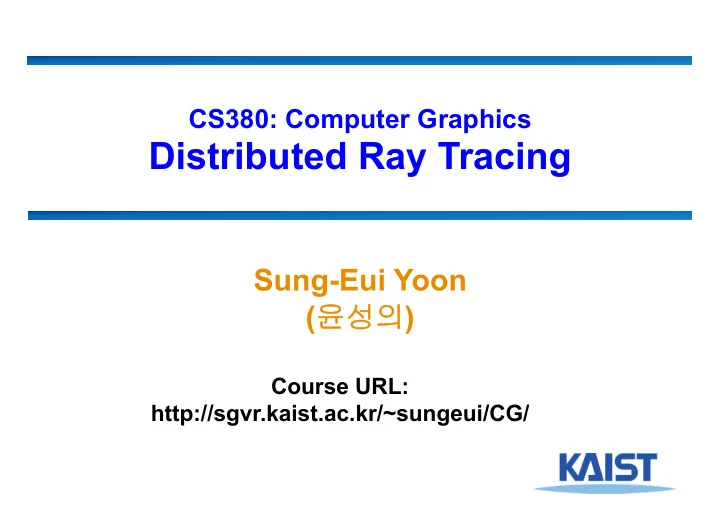

CS380: Computer Graphics Distributed Ray Tracing Sung-Eui Yoon ( 윤성의 ) Course URL: http://sgvr.kaist.ac.kr/~sungeui/CG/
Class Objectives ● Support various effects based on distributed ray tracing ● Acceleration methods ● Random sampling, jittering, in each pixel ● At the last time: ● Ray generations of ray tracing ● Intersection tests w/ implicit equations 2
Questions ● it seems ray tracing simulates reflection and refraction of light. However, there are also other properties of light, like diffraction or interference. Is there any technique simulating those properties? 3
Generalizing to Triangles ● Find of the point of intersection on the plane containing the triangle ● Determine if the point is inside the triangle ● Barycentric coordinate method ● Many other methods v 1 v 2 p v 3 o 4
Barycentric Coordinates ● Points in a triangle have positive barycentric coordinates: v 1 v 2 p v 3 1 ,where p v v v 0 1 2 v 2 ( ) ( ) p v v v v v 0 1 0 2 0 ( 1 ) p p v v v 0 1 2 v 1 v 0 5
Barycentric Coordinates ● Points in a triangle have positive barycentric coordinates: v 1 v 2 p v 3 1 ,where p v v v 0 1 2 ● Benefits: ● Barycentric coordinates can be used for interpolating vertex parameters (e.g., normals, colors, texture coordinates, etc) 6
Ray-Triangle Intersection ● A point in a ray intersects with a triangle v 1 ( ) ( ) ( ) p t v v v v v 0 1 0 2 0 v 2 p v 3 ● Three unknowns, but three equations ● Compute the point based on t ● Then, check whether the point is on the triangle 7
Pros and Cons of Ray Tracing Advantages of Ray Tracing: ● Very simple design ● Improved realism over the graphics pipeline Disadvantages: ● Very slow per pixel calculations ● Only approximates full global illumination ● Hard to accelerate with special-purpose H/W 8
Acceleration Methods ● Rendering time for a ray tracer depends on the number of ray intersection tests per pixel The number of pixels X the number of primitives in the scene ● ● Early efforts focused on accelerating the ray- object intersection tests ● More advanced methods required to make ray tracing practical ● Bounding volume hierarchies ● Spatial subdivision 9
Bounding Volumes ● Enclose complex objects within a simple-to- intersect objects If the ray does not intersect the simple object then its contents ● can be ignored The likelihood that it will strike the object depends on how ● tightly the volume surrounds the object. Potentially tighter fit, but with higher computation 10
Hierarchical Bounding Volumes ● Organize bounding volumes as a tree ● Each ray starts with the root BV of the tree and traverses down through the tree r 11
Spatial Subdivision Idea: Divide space in to subregions ● Place objects within a subregion into a list ● Only traverse the lists of subregions that the ray passes through ● “Mailboxing” used to avoid multiple test with objects in multiple regions ● Many types Regular grid ● Octree ● BSP tree ● kd-tree ● 12
Kd-tree: Example 13
Kd-tree: Example 14
Kd-tree: Example 15
Example 16
Kd-tree: Example What about triangles overlapping the split? 17
Kd-tree: Example 18
Other Optimizations ● Shadow cache ● Adaptive depth control ● Lazy geometry loading/creation 19
Distributed Ray Tracing [Cook et al. 84] ● Cook et al. realized that ray-tracing, when combined with randomized sampling, i.e., “jittering”, could be adapted to address a wide range of rendering problems: 20
Soft Shadows ● Take many samples from area light source and take their average ● Computes fractional visibility leading to penumbra 21
Antialiasing ● The need to sample is problematic because sampling leads to aliasing ● Solution 1: super-sampling Increases sampling rate, but does not completely eliminate ● aliasing Difficult to completely eliminate aliasing without prefiltering ● because the world is not band-limited 22
Antialiasing ● Solution 2: distribute the samples randomly Converts the aliasing energy to noise which is less ● objectionable to the eye Instead of casting one ray per pixel, cast several sub- sampling. Instead of uniform sub- sampling, jitter the pixels slightly off the grid. 23
Jittering Results for Antialiasing 2x2 sub-sampling 24
Depth-of-Field ● Rays don’t have to all originate from a single point. ● Real cameras collects rays over an aperture Can be modeled as a disk ● Final image is blurred away from the focal plane ● Gives rise to depth-of-field effects ● 25
Depth of Field focal plane lens image plane 26
Depth of Field ● Start with normal eye ray and find intersection with focal plane ● Choose jittered point on lens and trace line from lens point to focal point focal plane lens 27
Motion Blur ● Jitter samples through time ● Simulate the finite interval that a shutter is open on a real camera 28
Motion Blur 29
Complex Interreflection ● Model true reflection behavior as described by a full BRDF ● Randomly sample rays over the hemisphere, weight them by their BRDF value, and average them together ● This technique is called “Monte Carlo Ray Tracing” 30
Summary up to mid-term exam 31
Summary after that 32
Related Courses ● CS580: Advanced Computer Graphics ● Focus on rendering techniques that generate photo-realistic images ● CS482: Interactive Computer Graphics ● Interactive global illumination implemented by rasterization approaches ● Techniques used in recent games ● I’ll teach it at Fall of 2021 33
Recommend
More recommend